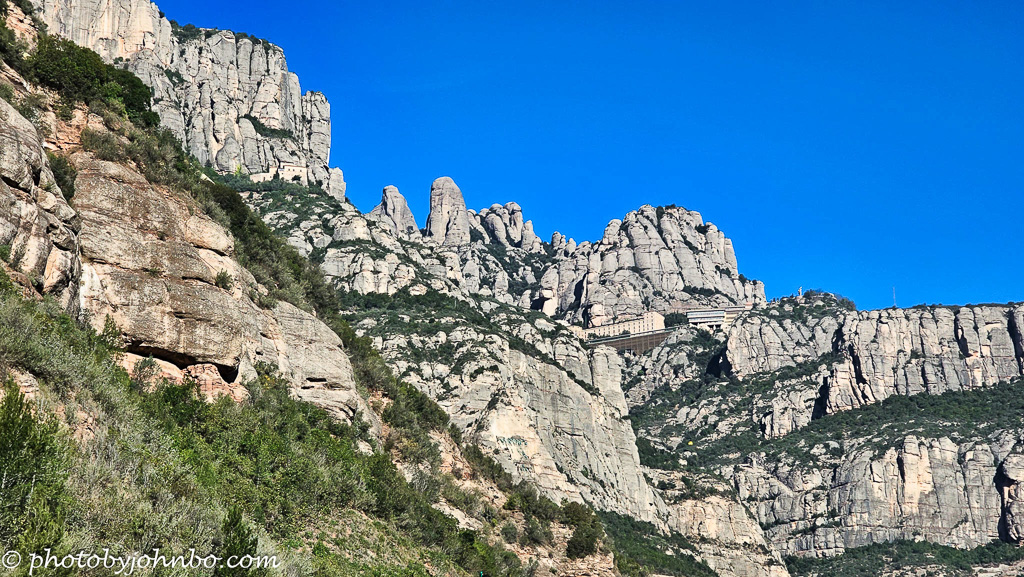
Catalonia, Spain.
Montserrat is high above Barcelona. During our two-day stay in the city, we hired a Viator tour affiliate to share some of the activities and historical sites around Barcelona. Nestled within the high mountain landscape is the Santa Maria de Montserrat Abbey, a Benedictine monastery that has been a significant religious and cultural center for centuries.
The site’s history as a retreat goes back to the 9th century. The first mention was in 880 AD when a small, isolated community of hermits sought solitude and spiritual contemplation on the mountain.
In the 10th century, a group of Benedictine monks established a more permanent presence on the mountain. They built a small chapel and began to cultivate the land. Over the centuries, the monastery grew in size and influence. It became a center of learning and spirituality, attracting pilgrims and scholars from throughout Europe. Our first stop was a visit to the Basilica. The tour guides provided tickets to view the most popular attraction, the Black Madonna. We were told that the Black Madonna of Montserrat is a 12th-century Romanesque sculpture that has become a revered religious icon.
The line was long, and it wound through the basilica and up several levels of stairs. We passed several altars. The basilica is a place of great religious importance, and each altar has a specific meaning or purpose. If you find an altar of particular significance, be prepared to capture a photo of the signage. I neglected to do that.
We continued to slowly advance upward on the stairway to the shrine of the Black Madonna. Though there were many steps to climb, the pace of the line was such that we were not struggling. However, it’s best to defer to the staff regarding the climb if climbing stairs is difficult for anyone in your party.
The sculpture is made of dark-colored wood, likely poplar, so it has come to be named “Black Madonna.” Over time, the wood has darkened due to age and exposure to elements. Its unique appearance and miraculous attributes have attracted pilgrims and devotees for centuries.
The time to view the Madonna is not long. She appears from around a corner at the top of the stairs. No seating or space for standing exists, so people don’t tarry as they pass by. Take a photo or two to contemplate the artwork after leaving the abbey. You won’t have time to explore the artistic details during your viewing. Yes, that’s a negative for a long time in the queue, to spend but moments viewing the artwork. She wears a golden crown, symbolizing her royal status and divine nature, and is holding the infant Jesus, also made of dark wood and depicted serenely.
After our viewing, the queue led us to a courtyard with spectacular artwork nestled between arches that provide fabulous views of the mountain peaks above. A small building at the top of a crevice is the terminus for the Funicular that can take you up the mountain.
As I noted in a recent Cellpic Sunday featuring the Funicular, we didn’t have enough time before our guides picked us up to navigate the long queue to ride to the top.
Other attractions at the monastery include a museum. Explore the art collection, including works by famous artists like El Greco, Caravaggio, and Picasso. You can also ride a cable car to the summit of Montserrat for panoramic views of the mountain range and the surrounding area.
Hikers will certainly enjoy the trails, and bikers can even rent a bike from the monastery to explore the mountain trails.
Guided monastery tours are also available to learn more about the monastery’s history, architecture, and spiritual significance. Tours are pre-arranged, and advance reservations are required, especially in peak season. Though we thought our time was adequate for the visit, we learned that we could have seen much more at the monastery had we allocated more time.
We found the crowded atmosphere a disadvantage, but that’s often the price of a site’s popularity. The lines can be long, so pack plenty of patience. You can check out my Flickr gallery in 2K HD here, and I even included some images that were not featured in this post.
John Steiner










Yes Catalonia is a beautiful place, it is very nice. But, Catalonia is not Spain. It is under Spanish dictatorship, unfortunately.
You know, I knew that. Even the cruise lines call it Spain on their excursions. I understand.
It’s a spectacular location, isn’t it? A real regret that I didn’t visit on my trip to Barcelona. Great photos, John.
Thanks, Jo!
A spectacular place with the natural surroundings.
Indeed!
A shame it’s so crowded by understandable given the location, beautiful setting and spiritual significance. When we visited the shrine of Guadalupe last year we were taken on a travelator to view the Virgin of Guadalupe. It seemed an oddly mechanised approach but did allow everyone a sight while ensuring no one lingered and blocked other people’s view!
I understand about the mechanized approach, but it sounds like a good way to approach the crowding problems.
It was, and the basilica was creatively designed so that the image could also be seen at a distance from every seat so anyone attending a mass could keep her in sight throughout
What a wonderful experience John! Thanks for bringing us along. I don’t think I could go up the Funicular, or down it!
I’d have loved to try, but our time was limited.
I love places like that. We enjoy going to churches and monasteries. This is a wonderful trip. Your photos are great!
It was a beautiful experience, even with the crowds.